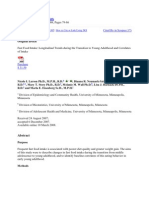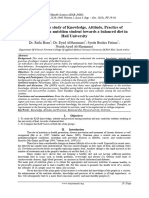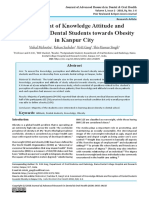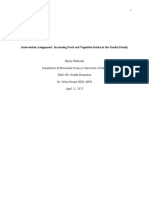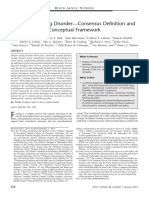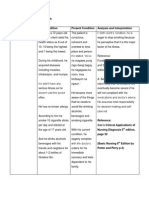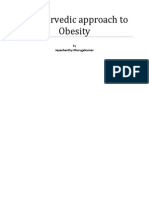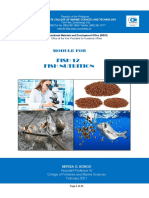0 ratings0% found this document useful (0 votes)
34 viewsSdarticle 112
Sdarticle 112
Uploaded by
Rio Michelle CorralesThis study evaluated a community-based intervention to reduce risk factors for falls and fractures in older adults. The intervention provided 16 educational sessions over 4 months to 849 older adults in Georgia senior centers. It focused on fall prevention behaviors and included physical activity. Participants showed significant increases in calcium/vitamin D intake and supplement use, as well as improvements in preventive behaviors and reductions in risk factors. The results provide evidence that the intervention improved behaviors important for reducing falls and fractures in older adults.
Copyright:
© All Rights Reserved
Available Formats
Download as PDF, TXT or read online from Scribd
Sdarticle 112
Sdarticle 112
Uploaded by
Rio Michelle Corrales0 ratings0% found this document useful (0 votes)
34 views2 pagesThis study evaluated a community-based intervention to reduce risk factors for falls and fractures in older adults. The intervention provided 16 educational sessions over 4 months to 849 older adults in Georgia senior centers. It focused on fall prevention behaviors and included physical activity. Participants showed significant increases in calcium/vitamin D intake and supplement use, as well as improvements in preventive behaviors and reductions in risk factors. The results provide evidence that the intervention improved behaviors important for reducing falls and fractures in older adults.
Original Description:
Reference007
Original Title
sdarticle_112
Copyright
© © All Rights Reserved
Available Formats
PDF, TXT or read online from Scribd
Share this document
Did you find this document useful?
Is this content inappropriate?
This study evaluated a community-based intervention to reduce risk factors for falls and fractures in older adults. The intervention provided 16 educational sessions over 4 months to 849 older adults in Georgia senior centers. It focused on fall prevention behaviors and included physical activity. Participants showed significant increases in calcium/vitamin D intake and supplement use, as well as improvements in preventive behaviors and reductions in risk factors. The results provide evidence that the intervention improved behaviors important for reducing falls and fractures in older adults.
Copyright:
© All Rights Reserved
Available Formats
Download as PDF, TXT or read online from Scribd
Download as pdf or txt
0 ratings0% found this document useful (0 votes)
34 views2 pagesSdarticle 112
Sdarticle 112
Uploaded by
Rio Michelle CorralesThis study evaluated a community-based intervention to reduce risk factors for falls and fractures in older adults. The intervention provided 16 educational sessions over 4 months to 849 older adults in Georgia senior centers. It focused on fall prevention behaviors and included physical activity. Participants showed significant increases in calcium/vitamin D intake and supplement use, as well as improvements in preventive behaviors and reductions in risk factors. The results provide evidence that the intervention improved behaviors important for reducing falls and fractures in older adults.
Copyright:
© All Rights Reserved
Available Formats
Download as PDF, TXT or read online from Scribd
Download as pdf or txt
You are on page 1of 2
S68 Poster Abstracts
P58 (continued) Results: There were significant (P 0.01) increases in the
intake of calcium- and vitamin D-rich foods (increased by
discussion, was implemented with a group of 25 Head Start 4 weekly servings), the use of calcium- or vitamin
Center supervisors and staff in San Luis Obispo County, D-containing supplements (8 to 9 percentage-point in-
CA. creases), and following 7 to 8 of the 8 fall preventive
Outcome Measures and Analysis: The program was eval- behaviors (pre: 35% vs. post: 51%), and decreases in overall
uated using a self-efficacy pre- and post-test of the training MORR ( 5-6 risk factors: pre: 19% vs. post: 9%).
participants. Paired t-tests were used to measure change in Conclusions and Implications: This evaluation provides
self-efficacy, skills and outcome expectancies from pre- to evidence that this intervention improves several preventive
post-test. behaviors that are important for decreasing the risk of falls
Results: Major results showed a significant (p 0.005) and fractures in older adults. This project was funded by the
increase in self-efficacy to: 1) communicate nutrition con- Georgia Division of Aging Services, the Northeast Georgia
cepts effectively; 2) influence changes in nutrition related Area Agency on Aging, and the University of Georgia.
attitudes; and 3) find resources to answer questions.
Conclusions and Implications: These results suggest that
facilitated group discussion, led by a skilled facilitator, can P60 Focus Groups to Inform the
be effective in increasing the self-efficacy of paraprofession-
Development of Online Theory Based
als working as nutrition educators.
Education in Breastfeeding Initiation Best
Practices
Jennifer Weddig, PhDc, RD, CLC, Metropolitan State
P59 Fall and Fracture Preventive Behaviors College of Denver, CB 33, Denver, CO 80217;
Increased Following a Community-Based Susan Baker, EdD, Department of Food Science and
Intervention in Older Adults in Georgia Human Nutrition, 214E Gifford Building, Colorado State
Senior Centers University, Fort Collins, CO 80523,
Jennifer Teems, BS, University of Georgia, 871 Meigs sbaker@cahs.colostate.edu; Garry Auld, PhD, RD,
Street, Athens, GA 30606, JET0802@uga.edu; Department of Food Science and Human Nutrition, 229
Tiffany Lommel, MS, RD, LD, University of Georgia, Gifford Building, Colorado State University, Fort Collins,
tsellers@uga.edu; Joan G. Fischer, PhD, RD, LD, CO 80523, auld@cahs.colostate.edu
University of Georgia, jfischer@fcs.uga.edu;
Objective: To determine what factors affect a registered
Jung Sun Lee, PhD, RD, LD, University of Georgia,
nurses ability to support their patient in breastfeeding
leejs@fcs.uga.edu; Sudha Reddy, MS, RD, LD, Georgia
initiation, if registered nurses have access to computers and
Department of Human Resources, Division of Aging
the computer skills necessary to complete an online course,
Services, sureddy@dhr.state.ga.us;
and what hospital policies and procedures, if any, impede a
Mary Ann Johnson, PhD, University of Georgia,
nurses ability to put their breastfeeding knowledge into
mjohnson@fcs.uga.edu
practice with their patients.
Design, Setting and Participants: Focus groups were con-
Objective: The purpose of this study was to evaluate a
ducted at 8 Colorado hospitals with over 40 nurses from
community-based intervention to reduce risk factors related
Labor/Delivery, NICU, Postpartum, and Pediatrics.
to falls and fractures in older adults.
Outcome Measures and Analysis: The focus group tran-
Design, Setting and Participants: The intervention took scripts were analyzed by hand and the main themes of the
place in Georgia senior centers and participants were a focus groups were extracted.
convenience sample (N 849; mean age 74; 83% Results: Most nurses report that: 1. They do not have
female; 55% white, 44% black, 1% other). official protocols for feeding. 2. They are supportive of
Intervention: The 4-month intervention consisted of 16 breastfeeding but lacked the hands on skills necessary to
sessions, eight of which focused on prevention of falls and assist dyads. 3. The infant is not given uninterrupted skin to
fractures, and incorporated components of the Health Be- skin contact during the first 2 hours after birth. 4. They did
lief Model. All 16 sessions included physical activity. not observe a dyad breastfeeding every shift and often never
Outcome Measures and Analysis: Pre- and post-tests were observed an actual feeding during a shift. 5. They are
interviewer-administered and evaluated fall preventive interested in additional education that would allow them to
home safety behaviors, intakes of calcium- and vitamin assess a dyad and provide help for common problems 6.
D-containing foods and supplements, and 6 modifiable They would benefit from an online course with a skills lab
osteoporosis-related risk (MORR) factors (low intake of and that they would have access to high speed internet to
calcium-rich food, non-use of a calcium supplement, non- allow for the course to include streaming video and other
use of a vitamin D-containing supplement, low physical
activity, high risk of falling, and current tobacco use). Continued on page S69
Journal of Nutrition Education and Behavior Volume 40, Number 4, July/August 2008 Supplement S69
P60 (continued) home and about one-third were experienced as a snack.
Saturated fat and sweets intakes were highest in indulgent
interactive tools 7. That getting CEUs for completion of escape occasions.
the course would be valuable and a motivator for partici- Conclusions and Implications: Attitude and eating occa-
pation. sion need state affect eating behaviors and should be con-
Conclusions and Implications: The focus groups informed sidered when developing tailored interventions to improve
the development of an online course teaching breastfeeding intake and control weight. This project was funded by NIH.
initiation best practices and policies that was conducted
during November 2007.
P62 Improving the Accuracy of a Self-
P61 Segmentation of Midlife Women by Administered Mailed 24-Hour Food Record
Noriko Sudo, PhD, RD, University of Minnesota,
Attitude and Eating Occasion Need State and
Department of Food Science and Nutrition, 1334 Eckles
Relationship to Obesity Indicators, Food Avenue, 225 FScN, St. Paul, MN 55108,
Group and Nutrient Intake sudox008@umn.edu; Courtney Perry, MS, RD, University
Noriko Sudo, PhD, RD, University of Minnesota, of Minnesota, Department of Food Science and
Department of Food Science and Nutrition, 1334 Eckles Nutrition, perry244@umn.edu; Marla Reicks, PhD, RD,
Avenue, 225 FScN, St. Paul, MN 55108, University of Minnesota, Department of Food Science
sudox008@umn.edu; Dennis Degeneffe, MBA, University and Nutrition, mreicks@umn.edu
of Minnesota, Department of Applied Economics, 317
Classroom Office Building, 1994 Buford Avenue, St. Objective: To determine the accuracy of a self-administered
Paul, MN 55108-6040, ddegenef@umn.edu;
mailed 24-hour food record (FR) by comparing the uncor-
Houa Vue, MS, RD, University of Minnesota,
rected FR (as received) to the FR corrected by telephone
Department of Food Science and Nutrition, 1334 Eckles
interview.
Avenue, 225 FScN, St. Paul, MN 55108,
Design, Setting and Participants: Forty midlife women (49
vuex0067@umn.edu; Marla Reicks, PhD, RD, University
of Minnesota, Department of Food Science and 1 5 years) were recruited from flyers on a university campus.
Nutrition, 1334 Eckles Avenue, 225 FScN, St. Paul, MN Women were mailed a FR booklet and a 16-page actual-size
55108, mreicks@umn.edu 2D food model booklet. The FR booklet instructed women
to describe foods consumed and preparation methods/
Objective: To segment women by attitude and eating oc- recipes. Women returned the completed uncorrected FR
casion need state and to determine the relationship be- form by mail and were interviewed by phone to review
tween these segments and obesity indicators, food group missing detail and clarify amounts and omissions (corrected
and nutrient intake. FR).
Design, Setting and Participants: Cross-sectional study Outcome Measures and Analysis: Pearsons correlation
with 200 midlife women (46 1 6 years). coefficients and mean differences were calculated for intake
Outcome Measures and Analysis: Women completed an of energy and nutrients between the uncorrected and cor-
Attitude/Control Belief Questionnaire once and an Eating rected FR.
Occasion Questionnaire for 3 eating occasions during Results: All intakes based on the uncorrected and cor-
3-days when diet records were collected. Cluster analyses rected FR were significantly correlated. Mean difference (1
segmented women based on attitudes toward food and SE) was the highest for energy (154 1 62 kcal) and the
eating occasions based on motivations underlying food lowest for vitamin E (0.57 1 0.40 mg). For all nutrients and
choices. energy, the uncorrected FR overestimated intakes. The
Results: Five attitude segments and six eating occasion most frequent missing data in the uncorrected FR was
need state segments were identified. Estimated marginal inadequate description of foods and inadequate descrip-
means of body mass index, waist circumference, and per- tion of serving sizes. The median number of food items (25
cent body fat were highest in attitude segments defined as and 75 percentiles) per FR with these types of missing data
impulsive eaters. Busy cooking avoiders had a higher was 3.5 (2.0, 5.8) and 1.0 (0.0, 1.0), respectively. Education
energy intake compared to women in other attitude seg-
level may have contributed to more frequent missing data
ments. Energy, total fat, and cholesterol consumption per
in the uncorrected FR.
occasion were highest in routine family meal occasions of
Conclusions and Implications: Even with use of well-
which more than 60% were dinner and eaten at home with
designed booklets, accuracy of mailed FR could be im-
children. The percentage of eating occasions in which
fruits/vegetables were eaten was also highest in routine proved via telephone interviews.
family meal followed by healthy regimen occasions. More
than half of indulgent escape occasions occurred away from
You might also like
- 100 Days in The Secret Place, 0768420652 PDFDocument160 pages100 Days in The Secret Place, 0768420652 PDFRio Michelle Corrales100% (7)
- ATI Nutrition Practice Exam B - Google Forms PDFDocument21 pagesATI Nutrition Practice Exam B - Google Forms PDFJohn Mixer33% (3)
- The Lean Mass DietDocument92 pagesThe Lean Mass Dietmortless86% (7)
- Encyclopedia of Canine Clinical Nutrition PDFDocument514 pagesEncyclopedia of Canine Clinical Nutrition PDFErika Villarreal100% (3)
- Essay Rubirc-Blooms TaxonomyDocument3 pagesEssay Rubirc-Blooms TaxonomyRio Michelle CorralesNo ratings yet
- Introducing Solid Foods and Vitamin and Mineral Supplementation During InfancyDocument35 pagesIntroducing Solid Foods and Vitamin and Mineral Supplementation During InfancyNorita AvilaNo ratings yet
- Assessment 1 Part A FinalDocument9 pagesAssessment 1 Part A Finalapi-253529065No ratings yet
- 1 s2.0 S1499404614006332 MainDocument6 pages1 s2.0 S1499404614006332 MainRico WoonNo ratings yet
- Graded - Joshua and AJ Needs AssessmentDocument16 pagesGraded - Joshua and AJ Needs Assessmentdr.ajbir33No ratings yet
- Impacts of Skipping Breakfast-22012022-2Document7 pagesImpacts of Skipping Breakfast-22012022-2Princess Joy LamerNo ratings yet
- Swoope1977 PDFDocument8 pagesSwoope1977 PDFKrupali JainNo ratings yet
- Fast FoodDocument8 pagesFast Foodkangna_sharma20No ratings yet
- Journal of School Health 2008 Fahlman A Pilot Study To Examine TheDocument7 pagesJournal of School Health 2008 Fahlman A Pilot Study To Examine TheMahmoud MagdyNo ratings yet
- Promoting Mealtime Function in People With Dementia: A Systematic Review of Studies Undertaken in Residential Aged CareDocument20 pagesPromoting Mealtime Function in People With Dementia: A Systematic Review of Studies Undertaken in Residential Aged CaremalnatsNo ratings yet
- A Comparative Study of Knowledge, Attitude, Practice of Nutrition and Non-Nutrition Student Towards A Balanced Diet in Hail UniversityDocument8 pagesA Comparative Study of Knowledge, Attitude, Practice of Nutrition and Non-Nutrition Student Towards A Balanced Diet in Hail UniversityIndermeet Singh AnandNo ratings yet
- 1 s2.0 S2475299124006693 MainDocument1 page1 s2.0 S2475299124006693 MainYULISSA FLORES RONDONNo ratings yet
- Sdarticle 142 PDFDocument1 pageSdarticle 142 PDFRio Michelle CorralesNo ratings yet
- Squire's Quest!: Dietary Outcome Evaluation of A Multimedia GameDocument10 pagesSquire's Quest!: Dietary Outcome Evaluation of A Multimedia Gamebisma_aliyyahNo ratings yet
- P10 Jumping Jacks With Jill-Nutrition Education Through EntertainmentDocument1 pageP10 Jumping Jacks With Jill-Nutrition Education Through EntertainmentRio Michelle CorralesNo ratings yet
- EBSCO FullText 2023 11 14Document10 pagesEBSCO FullText 2023 11 14Steven AnteauNo ratings yet
- Assessment of Knowledge Attitude and Perception of Dental Students Towards Obesity in Kanpur CityDocument6 pagesAssessment of Knowledge Attitude and Perception of Dental Students Towards Obesity in Kanpur CityAdvanced Research PublicationsNo ratings yet
- The Impact of Cooking Knowledge Attitude Behavior and Food SecDocument117 pagesThe Impact of Cooking Knowledge Attitude Behavior and Food Secdeosalvadorapril23No ratings yet
- Research Article Preferences and Perceived Value of WIC Foods Among WIC CaregiversDocument10 pagesResearch Article Preferences and Perceived Value of WIC Foods Among WIC Caregiversapi-464882482No ratings yet
- An Obesity Risk Assessment Tool For Young Childr 2018 Journal of Nutrition EDocument13 pagesAn Obesity Risk Assessment Tool For Young Childr 2018 Journal of Nutrition EErik agustioNo ratings yet
- J Jneb 2014 06 002Document6 pagesJ Jneb 2014 06 002Zhewen TangNo ratings yet
- Oaa Literature ReviewDocument29 pagesOaa Literature Reviewapi-290929891No ratings yet
- F (KM) PF1 (RD Shu SS) Pfa (Ab KM) PN (KM)Document7 pagesF (KM) PF1 (RD Shu SS) Pfa (Ab KM) PN (KM)Indermeet Singh AnandNo ratings yet
- An20221017 844Document6 pagesAn20221017 844Gaddafi PhelixNo ratings yet
- Toward Better Understanding of Pediatric Feeding DisorderDocument5 pagesToward Better Understanding of Pediatric Feeding Disorderdeborah lúcia feitosa montenegroNo ratings yet
- Chapte 1 2 - Group 5 1Document19 pagesChapte 1 2 - Group 5 1arlenetacla12No ratings yet
- Dodgson 2013Document8 pagesDodgson 2013gabriela.grover.invest.nutNo ratings yet
- Journal of Health EducationDocument10 pagesJournal of Health Educationfenska frianaNo ratings yet
- Megan Rollo ThesisDocument10 pagesMegan Rollo Thesistinamclellaneverett100% (1)
- Lill Lllly YyDocument8 pagesLill Lllly YyNeat ScriptNo ratings yet
- ReportDocument74 pagesReportNimesha GammanpilaNo ratings yet
- G8 Proposal DefenseDocument15 pagesG8 Proposal DefenseJogil ParaguaNo ratings yet
- Characterizing International Approaches To Weaning Children From Tube Feeding - A Scoping ReviewDocument12 pagesCharacterizing International Approaches To Weaning Children From Tube Feeding - A Scoping Revieweo.mobilestoreNo ratings yet
- 2.Document12 pages2.CatarinaBarros30No ratings yet
- Diet Quality of US Adolescents During The Transition To Adulthood: Changes and PredictorsDocument9 pagesDiet Quality of US Adolescents During The Transition To Adulthood: Changes and PredictorsmiraandrianiNo ratings yet
- Intervention AssignmentDocument11 pagesIntervention Assignmentapi-650024037No ratings yet
- Healthy Teens Counseling ApproachDocument6 pagesHealthy Teens Counseling ApproachDebbie CharlotteNo ratings yet
- Pediatric Feeding DisorderDocument6 pagesPediatric Feeding DisorderNadia Desanti RachmatikaNo ratings yet
- Fnut 11 1270048Document16 pagesFnut 11 1270048vivianelimaliveNo ratings yet
- Radcliffe, B (2011)Document8 pagesRadcliffe, B (2011)gabriela.grover.invest.nutNo ratings yet
- Communities: The ATLAS RCT Smart-Phone Obesity Prevention Trial For Adolescent Boys in Low-IncomeDocument11 pagesCommunities: The ATLAS RCT Smart-Phone Obesity Prevention Trial For Adolescent Boys in Low-IncomeAndressa SobrinhoNo ratings yet
- s41366-021-00765-xDocument25 pagess41366-021-00765-xcleanspacerNo ratings yet
- Correlation of Mother’s Knowledge on ChildDocument8 pagesCorrelation of Mother’s Knowledge on ChildUuziNo ratings yet
- Smart-Phone Obesity Prevention Trial For Adolescent Boys in Low-Income Communities: The ATLAS RCTDocument11 pagesSmart-Phone Obesity Prevention Trial For Adolescent Boys in Low-Income Communities: The ATLAS RCTIkaRiskyMuharominNo ratings yet
- ladas2006Document6 pagesladas2006lexiNo ratings yet
- Nutrition EducationDocument12 pagesNutrition EducationAbdurahman MohamoudNo ratings yet
- CV Corporate Mihai NiculescuDocument15 pagesCV Corporate Mihai NiculescuMari FereNo ratings yet
- NIH Public AccessDocument22 pagesNIH Public AccessJolina MontesaNo ratings yet
- Symposium: Challenges in Targeting Nutrition ProgramsDocument5 pagesSymposium: Challenges in Targeting Nutrition ProgramsMukhlidahHanunSiregarNo ratings yet
- Understanding Implementation and Improving Nutrition InterventionsDocument9 pagesUnderstanding Implementation and Improving Nutrition Interventionsprav.sharma1No ratings yet
- Knowledge, Attitudes and Practices of Food Handlers in Food SafetyDocument33 pagesKnowledge, Attitudes and Practices of Food Handlers in Food SafetyKurnia Nur KhamimahNo ratings yet
- Application of HBMDocument15 pagesApplication of HBMSashwat TanayNo ratings yet
- Fast Food Consumption Pattern and Its Association With Overweight Among High School Boys in Mangalore City of Southern IndiaDocument5 pagesFast Food Consumption Pattern and Its Association With Overweight Among High School Boys in Mangalore City of Southern IndiaAlicia SánchezNo ratings yet
- Nutrition Programmes For Individuals Living With Disadvantage in Supported Residential Settings A Scoping ReviewDocument12 pagesNutrition Programmes For Individuals Living With Disadvantage in Supported Residential Settings A Scoping ReviewMaría Francisca Cabezas HenríquezNo ratings yet
- SdarticleDocument10 pagesSdarticleshark7525No ratings yet
- 2008 FnceposterDocument1 page2008 Fnceposterapi-235820714No ratings yet
- Et PosterDocument1 pageEt Posterapi-317153964No ratings yet
- The Problem and Its BackgroundDocument37 pagesThe Problem and Its BackgroundKyra MedinaNo ratings yet
- Guidelines for assessing postnatal problemsDocument8 pagesGuidelines for assessing postnatal problemsBárbara Monique AlvesNo ratings yet
- Food Thesis AbstractDocument4 pagesFood Thesis Abstractdnr3krf8100% (3)
- Simmiliar SentenseDocument10 pagesSimmiliar Sentensesulasmi1998.2No ratings yet
- Guidelines for Assessing Nutrition-Related Knowledge, Attitudes and PracticesFrom EverandGuidelines for Assessing Nutrition-Related Knowledge, Attitudes and PracticesNo ratings yet
- Relationship Between Health Literacy Scores and Patient Use of the iPET for Patient EducationFrom EverandRelationship Between Health Literacy Scores and Patient Use of the iPET for Patient EducationNo ratings yet
- Mailman School Syllabus ToolkitDocument30 pagesMailman School Syllabus ToolkitRio Michelle CorralesNo ratings yet
- Rebuilding After Typhoon Haiyan: 'Every Time There Is A Storm I Get Scared'Document2 pagesRebuilding After Typhoon Haiyan: 'Every Time There Is A Storm I Get Scared'Rio Michelle CorralesNo ratings yet
- Dresden, Germany: Jose Rizal's Grand Tour of Europe With Maximo ViolaDocument3 pagesDresden, Germany: Jose Rizal's Grand Tour of Europe With Maximo ViolaRio Michelle CorralesNo ratings yet
- A Mighty Fortress Is Our God: CCLI Song No.:1293554, Topic:God The Father: Person and Praise Tunes:Ein'Feste BurgDocument5 pagesA Mighty Fortress Is Our God: CCLI Song No.:1293554, Topic:God The Father: Person and Praise Tunes:Ein'Feste BurgRio Michelle CorralesNo ratings yet
- How Do I Create A Test For My Students White PaperDocument6 pagesHow Do I Create A Test For My Students White PaperKornelia NitaNo ratings yet
- 07 LCD Slide Handout 1 PDFDocument7 pages07 LCD Slide Handout 1 PDFRio Michelle CorralesNo ratings yet
- Image Source:: Property of STIDocument1 pageImage Source:: Property of STIRio Michelle CorralesNo ratings yet
- CockroachDocument1 pageCockroachRio Michelle CorralesNo ratings yet
- Las Positas College Curriculum Handbook Revised Draft For 2012-13Document72 pagesLas Positas College Curriculum Handbook Revised Draft For 2012-13Rio Michelle CorralesNo ratings yet
- To The Filipino Youth 1879Document1 pageTo The Filipino Youth 1879Rio Michelle CorralesNo ratings yet
- 04 Handout 1 PDFDocument1 page04 Handout 1 PDFRio Michelle CorralesNo ratings yet
- 02 Handout 1Document1 page02 Handout 1Rio Michelle CorralesNo ratings yet
- 01 Handout 1Document1 page01 Handout 1Rio Michelle CorralesNo ratings yet
- Group Name: Members:: Property of STIDocument1 pageGroup Name: Members:: Property of STIRio Michelle CorralesNo ratings yet
- Managing Intergroup ConflictDocument6 pagesManaging Intergroup ConflictRio Michelle CorralesNo ratings yet
- Crlo Jprizal MTH 0830-1000Document1 pageCrlo Jprizal MTH 0830-1000Rio Michelle CorralesNo ratings yet
- Crlo Humbeorg MTH 1430-1600Document1 pageCrlo Humbeorg MTH 1430-1600Rio Michelle CorralesNo ratings yet
- Managing Intergroup Conflict Through NegotiationDocument7 pagesManaging Intergroup Conflict Through NegotiationRio Michelle CorralesNo ratings yet
- 08 Handout 1Document2 pages08 Handout 1Rio Michelle Corrales100% (1)
- The Circadian Code (Slide Show) - Satchin PandaDocument14 pagesThe Circadian Code (Slide Show) - Satchin PandaMeshach Parasuraman100% (2)
- Review Unit 1,2,3Document17 pagesReview Unit 1,2,3Trang Thùy VươngNo ratings yet
- 10 Scientific Ways To Lose WeightDocument20 pages10 Scientific Ways To Lose WeightFatimah AfzalNo ratings yet
- Evaluating The Food Consumption of Senior High School Students During The COVID-19 PandemicDocument18 pagesEvaluating The Food Consumption of Senior High School Students During The COVID-19 PandemicNina Jasmin100% (1)
- 101 Fat Loss FixesDocument108 pages101 Fat Loss FixesHarry Chriz83% (6)
- Eating Competence: Nutrition Education With The Satter Eating Competence ModelDocument6 pagesEating Competence: Nutrition Education With The Satter Eating Competence ModelMacarena VargasNo ratings yet
- Unani Medicine in The Nineteenth-Century Public Sphere - Urdu Texts and The Oudh Akhbar Seema Alavi 2005Document30 pagesUnani Medicine in The Nineteenth-Century Public Sphere - Urdu Texts and The Oudh Akhbar Seema Alavi 2005Ananda KhannaNo ratings yet
- Gordon's Pattern of Health: He Assumes Total Responsibility For Decision-Making and Self-Care - NotDocument6 pagesGordon's Pattern of Health: He Assumes Total Responsibility For Decision-Making and Self-Care - NotleibogiciousNo ratings yet
- Persuasive Speech OutlineDocument32 pagesPersuasive Speech OutlineMega Devega ArvianyNo ratings yet
- CHAPTER 9 - MOTIVATION AND EMOTION PPTDocument60 pagesCHAPTER 9 - MOTIVATION AND EMOTION PPTarushiNo ratings yet
- Social and Psychological Factors Affecting Eating Habits Among University StudentsDocument8 pagesSocial and Psychological Factors Affecting Eating Habits Among University StudentsJoilane Alves Pereira FreireNo ratings yet
- Baby Led Weaning Vs Parent LedDocument12 pagesBaby Led Weaning Vs Parent LedAdil SultaniNo ratings yet
- Notes 6 - Eating DisordersDocument17 pagesNotes 6 - Eating DisordersPoorti100% (1)
- Eat To Live or Live To EatDocument8 pagesEat To Live or Live To Eatt97p2dvk8tNo ratings yet
- An Ayurvedic Approach To ObesityDocument11 pagesAn Ayurvedic Approach To ObesitySanjay SoniNo ratings yet
- Eating Disorder.. ) )Document45 pagesEating Disorder.. ) )Joy HoNo ratings yet
- Does Stress Influence Sleep Patterns Food Intake WDocument18 pagesDoes Stress Influence Sleep Patterns Food Intake Wpiyush thawraniNo ratings yet
- (ENG) The General Dietary Guidelines For Koreans PDFDocument12 pages(ENG) The General Dietary Guidelines For Koreans PDFSophia AlvarengaNo ratings yet
- Week 11 - Navigating Emotional EatingDocument14 pagesWeek 11 - Navigating Emotional Eatingapi-568534737No ratings yet
- Sneaky Hacks That Boost MetabolismDocument11 pagesSneaky Hacks That Boost MetabolismLois JNo ratings yet
- Special DietsDocument52 pagesSpecial DietsMara Faye R. AvilesNo ratings yet
- The End of Overeating Taking Control of the Insatiable American Appetite 1st Edition David Kessler all chapter instant downloadDocument60 pagesThe End of Overeating Taking Control of the Insatiable American Appetite 1st Edition David Kessler all chapter instant downloadbellenteffo100% (2)
- Programming With STM32: Getting Started With The Nucleo Board and C/C++ - Ebook PDF All Chapters Instant DownloadDocument51 pagesProgramming With STM32: Getting Started With The Nucleo Board and C/C++ - Ebook PDF All Chapters Instant Downloadrenxopatyk100% (5)
- Nutri Food LogDocument9 pagesNutri Food LogGABRIEL AUDREY SOLONNo ratings yet
- Fish-12-Module 8Document25 pagesFish-12-Module 8Lemark Galban Lanat100% (2)











